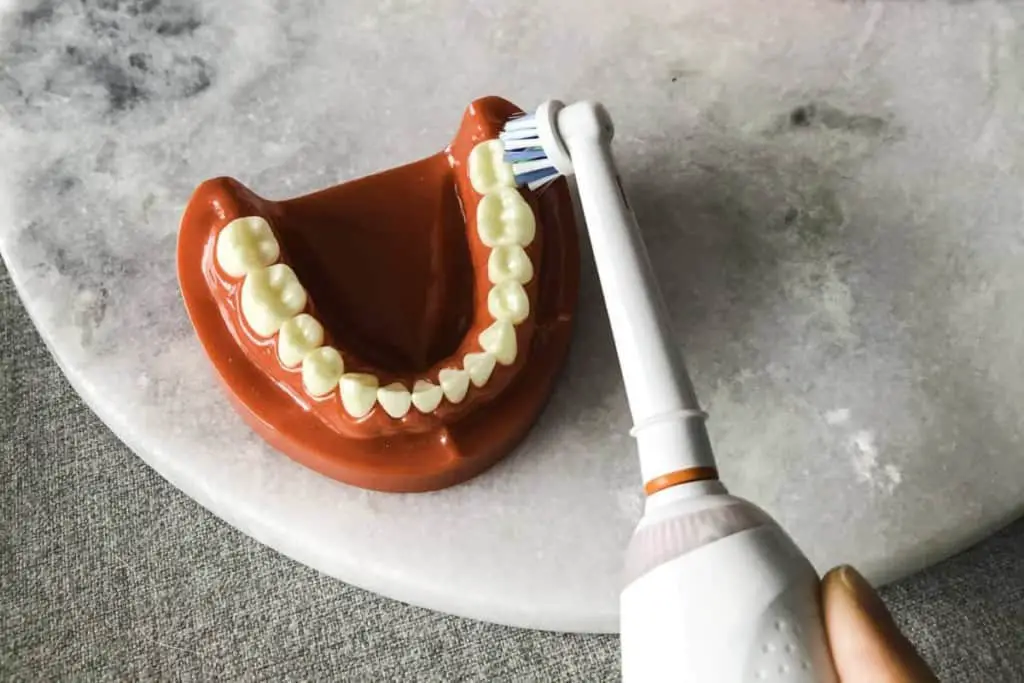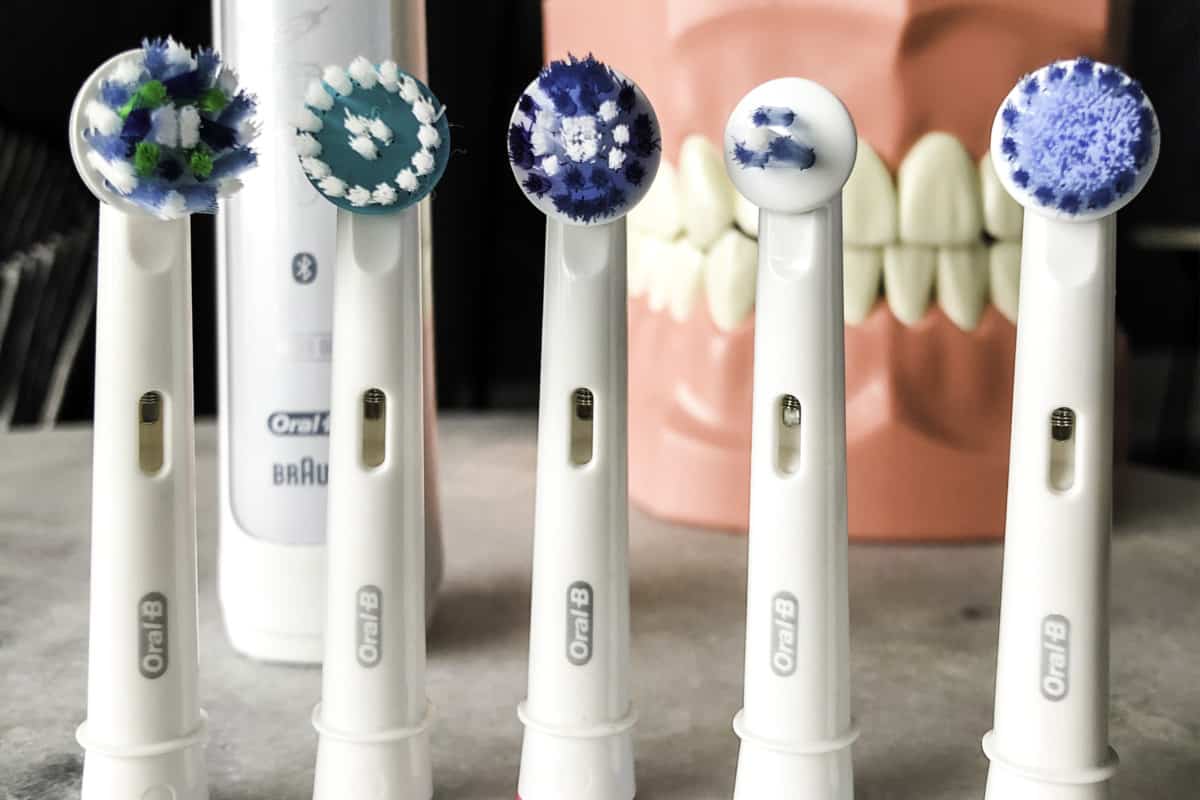
Who even reads the instructions of a toothbrush anyway?
I know I’ve never done it.
And to be honest the only reason I know how to properly use an electric toothbrush is because of dental hygiene school. No one ever showed me before that.
Lately, I’ve made an effort to ask my patients how they brush with their electric toothbrush, and most of them are doing it incorrectly which can lead to more serious issues.
I really don’t want my patients emptying their pockets for expensive dental treatments later on, and just reviewing a simple thing like brushing technique can go a long way and prevent those expensive fixes.
It got me thinking about how many people actually don’t know the proper way to use an electric toothbrush, with many people using it the same way as a normal manual toothbrush.
How to properly use the Oral-B electric toothbrush
Steps:
- Floss or clean between your teeth.

- This clears out the bacteria and food debris so the toothpaste can flow through the teeth and be effective in between the teeth.
- If you don’t floss first, the toothpaste won’t be able to penetrate the plaque in between the teeth to prevent cavities.
- Wet the toothbrush head if you want, but you don’t have to.
- Put a pea-sized amount of toothpaste on the brush head. This is why you don’t need more
 .
. - Only turn on the brush once it’s in your mouth against the teeth and gums. If you don’t do this, you will end up with a messy face, clothes and bathroom surfaces.
- Time to brush.
- Make sure you have the toothbrush bristles angled at a 45-degree angle down along the gumline, staying on each tooth for a few seconds. Slowly move the brush to angle it more in-between the teeth, then move to the next tooth.
- The 45-degree angle will allow the bristles to move under the gumline, removing more plaque, meaning a healthier mouth.
- Slight pressure is sufficient, most Oral-B models have a pressure sensor and will flash red and lower the power when you are brushing too hard.
- Follow a routine and pay attention to the 30-second intervals. Brush each quadrant of your mouth for 30 seconds. Places that are often missed are;
- The back surfaces of the last teeth.

- Areas that build up more tartar (calculus) – the inside of the lower front teeth and the outside of the upper back teeth.

- DO NOT scrub your teeth, your hand barely has to move. The more you scrub, the more damage you WILL do.
- Clean your tongue, cheeks and roof of your mouth (not included in the 2-minute timer).
- Skip rinsing out your mouth.
- Not rinsing your mouth out after brushing will leave a layer of the active ingredient on your teeth, making the toothpaste much more effective.
- You can spit as much as you want, just do not rinse with water or mouthwash.
- Avoid anything by mouth for at least 30 minutes.

- Rinse off and store your toothbrush upright out in the open.
- It allows it to properly dry and reduce bacteria from using it as a nice home to reproduce.
- Store it as far away from your toilet as possible because every time you flush the toilet and don’t close the lid, it produces aerosols than can actually spread around 6 feet away from the toilet.
- And repeat! Use twice a day for the full 2 minutes.
- Floss and brush right before bed. Once you have done this you should avoid eating anything after.
- When we sleep our saliva flow basically turns off, so it’s not rinsing away the acid produced by the bacteria in your mouth.
- More bacteria=more acid=cavity formation. If you eat or drink anything but water after, you are feeding the bacteria to produce more acid, making it more likely that you will form a cavity.
- Make sure your electric toothbrush is charged.
- When the battery starts to die, the power will not be where it should be and can lower the effectiveness of the toothbrush.
Manual vs electric toothbrush
Both brushes will help in keeping your mouth healthy but the electric toothbrush has the upper edge. This article  combines 6 studies done that show that Oral-B electric toothbrushes are much more efficient at removing plaque.
combines 6 studies done that show that Oral-B electric toothbrushes are much more efficient at removing plaque.
Using an electric toothbrush has so many perks and benefits that help us become better healthier individuals.
Benefits of using an electric toothbrush
The people who benefit the most from using an electric toothbrush are;
- People with limited function and dexterity of their hands
- Those who have braces/orthodontic treatment
- Young kids and teens
- People who produce more build up on their teeth
The top 12 benefits of using an electric toothbrush will surprise you how great they really are!
will surprise you how great they really are!
Common mistakes and how to fix them
Length of time
Usually, people don’t brush for the full 2 minutes that is recommended by us dental professionals and dental associations. Brushing for a full 2 minutes is enough time to brush each tooth effectively, and preventing poor oral hygiene and gum disease.
The average time spent is actually around the 40-second mark, leaving lots of food debris and bacteria behind!
Technique
Most of the time people are brushing with their electric toothbrush as if it was a normal manual toothbrush.
Unknowingly when we brush incorrectly we are scrubbing away the gum and tooth surfaces. This can lead to root exposure due to gum recession and can cause really sensitive teeth. It can make you more prone to cavities along the root surface.

Once the gum tissues and tooth surfaces are gone, they can’t grow back and they are gone forever.
These preventable issues can lead to very expensive dental treatment such as fillings, fixing broken and chipped teeth with crowns, bridges and implants, and the list goes on.
Brush head (avoid generic)
A lot of people try and save money by purchasing generic versions of items and electric toothbrush heads are one of them.
Pleaseeeeee do not buy generic brush heads as they do not work as well. They are not made the same and can be completely ineffective.
I had this one patient who started using generic Oral-B heads without me knowing and when he came in for a cleaning I was surprised about how poor his oral hygiene was as compared to the last time I saw him.
With his oral health declining, we had to get to the bottom of it.
And at the bottom?
His generic Oral-B toothbrush head was not working properly.
It’s not just the crappy brushing that comes along with it but also, generic toothbrush heads can be potentially damaging to your health.
Why?
- They can be made in unsanitary factories
- Made with toxic materials and ink
- Parts can fall apart and cause a user to choke or swallow it
- Damage gums and teeth
How often should you change your brush head?
It is recommended to change your brush head around the 3-month mark. Oral-B brush heads actually have colour indicating bristles that will fade from a darker blue to lighter blue/white when it is time to change the head.
Keep an eye on the bristles of your toothbrush head. If they are becoming frayed and appear worn out before the 3-month mark it could mean that you are brushing too hard, or brushing with an incorrect technique that could be damaging your teeth and gums.
Using a worn-out head can make the toothbrush not work as great. The bristles are angled specifically to provide the highest quality clean.
If you get sick you will want to change your brush head as that yucky bacteria/virus can linger on the head.
It’s important to understand that changing your brush head is really important.
I had a patient whos oral hygiene was pretty poor and he was reporting to brushing 2 x a day for 2 minutes with his electric toothbrush. It didn’t add up.
I asked him when was the last time he changed the brush head and he said;
“I’ve never changed it”
After I was done internally freaking out, I asked him; “When did you get the electric toothbrush?”
He said; “almost 2 years ago”.
My mouth dropped opened and I told him he was supposed to change it every 3 months and we talked about why it is important to change it.
He simply just didn’t know you had to change it.
He said he was going to go home and change the brush head right away and because of this simple mistake and lack of knowledge, it negatively impacted his oral health.
What toothbrush head is the best for you?
The wonderful thing about Oral-B is that their brush heads are universal, with all the brush heads fitting the Oral-B electric toothbrushes. There is one exception and that is the pulsonic version.
The heads are all designed in collaboration with dentists to provide the consumer with the best available product for their needs.
Oral-B doesn’t take a “one size fits all” approach.
They have made brush heads for people who have;
- Sensitive teeth and gums

- Implants and bridges

- Orthodontic treatment; braces, space maintainers etc.

- People seeking whiter teeth

- Small mouths/limited opening

Finding the right brush head could mean a night and day difference in your oral health. I hope this post has a positive impact on your oral health routine.
Happy brushing!
Holly 🙂

